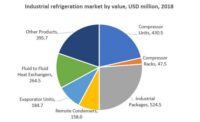The phaseout of ozone-depleting refrigerants marches on. Take a look at what is and isn’t allowed, and when.
The EPA published two rules in December 2009 that restrict the production and import of HCFC-22 - also known as R-22 or Freon® - and banned the distribution and sale of precharged A/C and refrigeration equipment and components containing HCFC-22 or HCFC-142B in the U.S. beginning January 1, 2010.
According to the EPA, the first rule, titled the 2010 HCFC Allocation Rule, complies with the 2010 phasedown caps set under the Montreal Protocol on Substances that Deplete the Ozone Layer. The protocol was ratified in 1988 and led to the creation of Title VI, Stratospheric Ozone Protection of the Clean Air Act.
This amendment set a schedule to phase out the production and consumption of HCFCs in the U.S. and classified refrigerants in two classes: Class I or Class II. Class I refrigerants were phased out on January 1, 2000. HCFC-14b was banned on January 1, 2003. Class II refrigerants are being gradually phased out with a complete ban by 2030, Class II refrigerants include HCFC–22, HCFC–142b, HCFC–123, HCFC–124, HCFC–225ca, and HCFC–225cb.
CONSUMPTION BASELINE DETERMINATION
The methodology for determining a country’s consumption baseline was determined by the Copenhagen Amendment to the Montreal Protocol, decided upon in 1992. Caps were set at 3.1%, later lowered to 2.8%, of a country’s 1989 HCFC consumption. In the U.S., the consumption baseline was set at 15,240 ozone depletion potential (ODP).
2010 AND BEYOND
The 2010 HCFC Allocation Rule sets HCFC limits for five years, starting in 2010 to 2014, allowing a decrease in the amount of HCFC-22 allocations every year to meet decreased demand, says the EPA. Prior rules were enacted to meet previous allocation caps. The total HCFCs allowed during the five-year period is 12,355 ODP-weighted metric tons for consumption and 11,621 ODP tons for production. The percentages are found in Table 1.
PRE-CHARGED APPLIANCE RULE
The second rule passed in December, 2009 is the Pre-Charged Appliances rule that, beginning January 1, 2010, bans the sale or distribution of A/C and refrigeration appliances and components containing HCFC-22, HCFC-14b, or a blend of these two refrigerants in units and components that were manufactured on or after the cut-off date.
The EPA defines appliances as equipment that may be manufactured and shipped pre-charged, such as:
-
Air-to-air heat pumps
-
Chest or upright freezers
-
Ductless air conditioners
-
Dehumidifiers
-
Ground-source heat pumps
-
Packaged A/C units and heat pumps
-
Unitary A/C units
-
Window A/C units
Affected components, according to the EPA, include condensers and line-sets that are precharged with refrigerant before sale or distribution.
The ban, according to the EPA, does not apply to appliances and components manufactured before the cut-off date, including stockpiled inventories. This ban also affects the import of appliances and components that are charged with HCFC-22 and HCFC-142b, of which 9.5 million pre-charged A/C and refrigeration appliances were imported into the U.S. between 2006 and 2008. Again, this ban applies to units manufactured on or after January 1, 2010, and applies whether the refrigerant is reclaimed or not, and does not affect the sale and distribution of what the EPA terms “pre-2010 inventory.” Use of virgin HCFC-22 and HCFC-142b in manufacturing new appliances is prohibited. However, the sale and distribution of used appliances is not affected.
Affected parties include A/C contractors, and manufacturers, wholesalers, and importers of air conditioners and refrigerators (Table 2).
EXCEPTIONS TO THE RULE
One exception to this rule is that pre-charged components manufactured before the cut-off date may be used to service appliances manufactured before the cut-off date but may not be used to create new appliances unless there is no use of virgin HCFC-22 and HCFC-142b. Virgin HCFC-22 and HCFC-142b can only be used to service existing appliances, according to the EPA, with one additional exception. HCFC-22 that was produced before the cut-off date can be used to manufacture medical equipment and thermostatic expansion valves until January 1, 2015.
One other exception “allows virgin HCFC-22 to be used in the onsite ‘manufacture’ of appliances for a particular project between January 1, 2010, and December 31, 2011, if the components have been specified for use at that project under a building permit or contract dated before January 1, 2010.”



